Structures and Fluorescent and Magnetic Behaviors of Newly Synthesized NiII and CuII Coordination Compounds
Abstract
:1. Introduction
2. Experimental Section
2.1. Materials and Methods
2.2. Synthesis of H2L1
2.3. Syntheses of the Coordination Compounds 1–4
2.4. Crystal Structure Determinations of the Coordination Compounds 1–4
3. Results and Discussion
3.1. IR Spectra
3.2. UV-vis Absorption Spectra
3.3. Descriptions of the Crystal Structures
3.3.1. Crystal Structures of the Coordination Compounds 1–3
3.3.2. Crystal Structure of the Coordination Compound 4
3.4. Solvent Effect
3.5. Fluorescence Behaviors
3.6. Magnetic Behavior
4. Conclusions
Supplementary Materials
Acknowledgments
Author Contributions
Conflicts of Interest
References
- Sun, Y.X.; Xu, L.; Zhao, T.H.; Liu, S.H.; Liu, G.H.; Dong, X.T. Synthesis and crystal structure of a 3D supramolecular copper(II) complex with 1-(3-{[(E)-3-bromo-5-chloro-2-hydroxybenzylidene]amino}phenyl) ethanone oxime. Synth. React. Inorg. Met.-Org. Nano-Met. Chem. 2013, 43, 509–513. [Google Scholar] [CrossRef]
- Sun, Y.X.; Zhang, Y.J.; Meng, W.S.; Li, X.R.; Lu, R.E. Synthesis and crystal structure of new nickel(II) complex with Salen-type bisoxime ligand. Asian J. Chem. 2014, 26, 416–418. [Google Scholar]
- Song, X.Q.; Liu, P.P.; Xiao, Z.R.; Li, X.; Liu, Y.A. Four polynuclear complexes based on a versatile salicylamide salen-like ligand: Synthesis, structural variations and magnetic properties. Inorg. Chim. Acta 2015, 438, 232–244. [Google Scholar] [CrossRef]
- Sun, Y.X.; Gao, X.H. Synthesis, characterization, and crystal structure of a new CuII complex with salen-type ligand. Synth. React. Inorg. Met.-Org. Nano-Met. Chem. 2011, 41, 973–978. [Google Scholar] [CrossRef]
- Li, L.H.; Dong, W.K.; Zhang, Y.; Akogun, S.F.; Xu, L. Syntheses, structures and catecholase activities of homo-and hetero-trinuclear cobalt(II) complexes constructed from an acyclic naphthalenediol-based bis(salamo)-type ligand. Appl. Organomet. Chem. 2017, 31, e3818. [Google Scholar] [CrossRef]
- Li, X.Y.; Chen, L.; Gao, L.; Zhang, Y.; Akogun, S.F.; Dong, W.K. Syntheses, crystal structures and catalytic activities of two solvent-induced homotrinuclear Co(II) complexes with a naphthalenediol-based bis(Salamo)-type tetraoxime ligand. RSC Adv. 2017, 7, 35905–35916. [Google Scholar] [CrossRef]
- Ene, C.D.; Nastase, S.; Maxim, C.; Madalan, A.M.; Tuna, F.; Andruh, M. The azidopentacyanoferrate(III) ion as a tecton in constructing heterometallic complexes: Synthesis, crystal structure and magnetic properties of [Mn(valphen)(H2O)2]2[(H2O)(valphen)Mn(μ-CN)Fe(CN)4(N3)]·8H2O. Inorg. Chim. Acta 2010, 363, 4247–4252. [Google Scholar] [CrossRef]
- Dong, W.K.; Ma, J.C.; Dong, Y.J.; Zhu, L.C.; Zhang, Y. Di- and tetranuclear heterometallic 3d–4f cobalt(II)–lanthanide(III) complexes derived from a hexadentate bisoxime: Syntheses, structures and magnetic properties. Polyhedron 2016, 115, 228–235. [Google Scholar] [CrossRef]
- Liu, P.P.; Sheng, L.; Song, X.Q.; Xu, W.Y.; Liu, Y.A. Synthesis, structure and magnetic properties of a new one dimensional manganese coordination polymer constructed by a new asymmetrical ligand. Inorg. Chim. Acta 2015, 434, 252–257. [Google Scholar] [CrossRef]
- Song, X.Q.; Liu, P.P.; Liu, Y.A.; Zhou, J.J.; Wang, X.L. Two dodecanuclear heterometallic [Zn6Ln6] clusters constructed by a multidentate salicylamide salen-like ligand: Synthesis, structure, luminescence and magnetic properties. Dalton Trans. 2016, 45, 8154–8163. [Google Scholar] [CrossRef] [PubMed]
- Wu, H.L.; Pan, G.L.; Wang, H.; Wang, X.L.; Bai, Y.C.; Zhang, Y.H. Study on synthesis, crystal structure, antioxidant and DNA-binding of mono-, di- and poly-nuclear lanthanides complexes with bis(N-salicylidene)-3-oxapentane-1,5-diamine. J. Photochem. Photobiol. B 2014, 135, 33–43. [Google Scholar] [CrossRef] [PubMed]
- Wu, H.L.; Pan, G.L.; Bai, Y.C.; Wang, H.; Kong, J.; Shi, F.; Zhang, Y.H.; Wang, X.L. Preparation, structure, DNA-binding properties, and antioxidant activities of a homodinuclear erbium(III) complex with a pentadentate Schiff base ligand. J. Chem. Res. 2014, 38, 211–217. [Google Scholar] [CrossRef]
- Wu, H.L.; Bai, Y.; Yuan, J.K.; Wang, H.; Pan, G.L.; Fan, X.Y.; Kong, J. A zinc(II) complex with tris(2-(N-methyl)benzimidazlylmethyl)amine and salicylate: Synthesis, crystal structure, and DNA-binding. J. Coord. Chem. 2012, 65, 2839–2851. [Google Scholar] [CrossRef]
- Wu, H.L.; Bai, Y.C.; Zhang, Y.H.; Pan, G.L.; Kong, J.; Shi, F.; Wang, X.L. Two lanthanide(III) complexes based on the schiff base N,N-Bis(salicylidene)-1,5-diamino-3-oxapentane: Synthesis, characterization, DNA-binding properties, and antioxidation. Z. Anorg. Allg. Chem. 2014, 640, 2062–2071. [Google Scholar] [CrossRef]
- Chen, C.Y.; Zhang, J.W.; Zhang, Y.H.; Yang, Z.H.; Wu, H.L. Gadolinium(III) and dysprosium(III) complexes with a Schiff base bis(N-salicylidene)-3-oxapentane-1,5-diamine: Synthesis, characterization, antioxidation, and DNA-binding studies. J. Coord. Chem. 2015, 68, 1054–1071. [Google Scholar] [CrossRef]
- Wu, H.L.; Wang, C.P.; Wang, F.; Peng, H.P.; Zhang, H.; Bai, Y.C. A new manganese(III) complex from bis(5-methylsalicylaldehyde)-3-oxapentane-1,5-diamine: Synthesis, characterization, antioxidant activity and luminescence. J. Chin. Chem. Soc. 2015, 62, 1028–1034. [Google Scholar] [CrossRef]
- Wu, H.L.; Pan, G.L.; Bai, Y.C.; Wang, H.; Kong, J. Synthesis, structure, antioxidation, and DNA-bindingstudies of a binuclear ytterbium(III) complex with bis(N-salicylidene)-3-oxapentane-1,5-diamine. Res. Chem. Intermed. 2015, 41, 3375–3388. [Google Scholar] [CrossRef]
- Dong, W.K.; Ma, J.C.; Zhu, L.C.; Zhang, Y. Nine self–assembled nickel(II)–lanthanide(III) heterometallic complexes constructed from a Salamo–type bisoxime and bearing N- or O-donor auxiliary ligand: Syntheses, structures and magnetic properties. New J. Chem. 2016, 40, 6998–7010. [Google Scholar] [CrossRef]
- Sun, Y.X.; Zhang, S.T.; Ren, Z.L.; Dong, X.Y.; Wang, L. Synthesis, characterization, and crystal structure of a new supramolecular CdII complex with halogen-substituted salen-type bisoxime. Synth. React. Inorg. Met.-Org. Nano-Met. Chem. 2013, 43, 995–1000. [Google Scholar] [CrossRef]
- Zhao, L.; Dang, X.T.; Chen, Q.; Zhao, J.X.; Wang, L. Synthesis, crystal structure and spectral properties of a 2D supramolecular copper(II) complex with 1-(4-{[(E)-3-ethoxyl-2-hydroxybenzylidene]amino}phenyl)ethanone oxime. Synth. React. Inorg. Met.-Org. Nano-Met. Chem. 2013, 43, 1241–1246. [Google Scholar] [CrossRef]
- Sun, Y.X.; Wang, L.; Dong, X.Y.; Ren, Z.L.; Meng, W.S. Synthesis, characterization, and crystal structure of a supramolecular CoII complex containing Salen-type bisoxime. Synth. React. Inorg. Met.-Org. Nano-Met. Chem. 2013, 43, 599–603. [Google Scholar] [CrossRef]
- Dong, W.K.; Li, X.L.; Wang, L.; Zhang, Y.; Ding, Y.J. A new application of Salamo-type bisoximes: As a relay-sensor for Zn2+/Cu2+ and its novel complexes for successive sensing of H+/OH−. Sens. Actuators B 2016, 229, 370–378. [Google Scholar] [CrossRef]
- Dong, W.K.; Akogun, S.F.; Zhang, Y.; Sun, Y.X.; Dong, X.Y. A reversible “turn-on” fluorescent sensor for selective detection of Zn2+. Sens. Actuators B 2017, 238, 723–734. [Google Scholar] [CrossRef]
- Wang, B.J.; Dong, W.K.; Zhang, Y.; Akogun, S.F. A novel relay-sensor for highly sensitive and selective detection of Zn2+/Pic- and fluorescence on/off switch response of H+/OH−. Sens. Actuators B 2017, 247, 254–264. [Google Scholar] [CrossRef]
- Wang, F.; Gao, L.; Zhao, Q.; Zhang, Y.; Dong, W.K.; Ding, Y.J. A highly selective fluorescent chemosensor for CN− based on a novel bis(salamo)-type tetraoxime ligand. Spectrochim. Acta Part A 2018, 190, 111–115. [Google Scholar] [CrossRef] [PubMed]
- Chai, L.Q.; Liu, G.; Zhang, Y.L.; Huang, J.J.; Tong, J.F. Synthesis, crystal structure, fluorescence, electrochemical property, and SOD-like activity of an unexpected nickel(II) complex with a quinazoline-type ligand. J. Coord. Chem. 2013, 66, 3926–3938. [Google Scholar] [CrossRef]
- Dong, W.K.; Lan, P.F.; Zhou, W.M.; Zhang, Y. Salamo-type trinuclear and tetranuclear cobalt(II) complexes based on a new asymmetry Salamotype ligand: Syntheses, crystal structures, and fluorescence properties. J. Coord. Chem. 2016, 69, 1272–1283. [Google Scholar] [CrossRef]
- Dong, W.K.; Zhang, J.; Zhang, Y.; Li, N. Novel multinuclear transition metal(II) complexes based on an asymmetric salamo-type ligand: Syntheses, structure characterizations and fluorescent properties. Inorg. Chim. Acta 2016, 444, 95–102. [Google Scholar] [CrossRef]
- Song, X.Q.; Zheng, Q.F.; Wang, L.; Liu, W.S. Synthesis and luminescence properties of lanthanide complexes with a new tripodal ligand featuring N-thenylsalicylamide arms. Luminescence 2012, 27, 459–465. [Google Scholar] [CrossRef] [PubMed]
- Dong, W.K.; Ma, J.C.; Zhu, L.C.; Zhang, Y. Self-assembled zinc(II)-lanthanide(III) heteromultinuclear complexes constructed from 3-MeOsalamo ligand: Syntheses, structures and luminescent properties. Cryst. Growth Des. 2016, 16, 6903–6914. [Google Scholar] [CrossRef]
- Chai, L.Q.; Tang, L.J.; Chen, L.C.; Huang, J.J. Structural, spectral, electrochemical and DFT studies of two mononuclear manganese(II) and zinc(II) complexes. Polyhedron 2017, 122, 228–240. [Google Scholar] [CrossRef]
- Chai, L.Q.; Zhang, K.Y.; Tang, L.J.; Zhang, J.Y.; Zhang, H.S. Two mono- and dinuclear Ni(II) complexes constructed from quinazoline-type ligands: Synthesis, X-ray structures, spectroscopic, electrochemical, thermal, and antimicrobial studies. Polyhedron 2017, 130, 100–107. [Google Scholar] [CrossRef]
- Hao, J.; Li, L.L.; Zhang, J.T.; Akogun, S.F.; Wang, L.; Dong, W.K. Four homo- and hetero-bismetallic 3d/3d-2s complexes constructed from a naphthalenediol-based acyclic bis(salamo)-type tetraoxime ligand. Polyhedron 2017, 134, 1–10. [Google Scholar] [CrossRef]
- Song, X.Q.; Wang, L.; Zheng, Q.F.; Liu, W.S. Synthesis, crystal structure and luminescence properties of lanthanide complexes with a new semirigid bridging furfurylsalicylamide ligand. Inorg. Chim. Acta 2012, 391, 171–178. [Google Scholar] [CrossRef]
- Liu, Y.A.; Wang, C.Y.; Zhang, M.; Song, X.Q. Structures and magnetic properties of cyclic heterometallic tetranuclear clusters. Polyhedron 2017, 127, 278–286. [Google Scholar] [CrossRef]
- Song, X.Q.; Peng, Y.J.; Chen, G.Q.; Wang, X.R.; Liu, P.P.; Xu, W.Y. Substituted group-directed assembly of Zn(II) coordination complexes based on two new structural related pyrazolone based Salen ligands: Syntheses, structures and fluorescence properties. Inorg. Chim. Acta 2015, 427, 13–21. [Google Scholar] [CrossRef]
- Dong, X.Y.; Li, X.Y.; Liu, L.Z.; Zhang, H.; Ding, Y.J.; Dong, W.K. Tri- and hexanuclear heterometallic Ni(II)–M(II) (M = Ca, Sr and Ba) bis(salamo)-type complexes: Synthesis, structure and fluorescence properties. RSC Adv. 2017, 7, 48394–48403. [Google Scholar] [CrossRef]
- Li, G.; Hao, J.; Liu, L.Z.; Zhou, W.M.; Dong, W.K. Syntheses, crystal structures and thermal behaviors of two supramolecular salamo-type cobalt(II) and zinc(II) complexes. Crystals 2017, 7, 217. [Google Scholar] [CrossRef]
- Song, X.Q.; Lei, Y.K.; Wang, X.R.; Zhao, M.M.; Peng, Y.Q.; Cheng, G.Q. Lanthanide coordination polymers: Synthesis, diverse structure and luminescence properties. J. Solid State Chem. 2014, 218, 202–212. [Google Scholar] [CrossRef]
- Dong, Y.J.; Dong, X.Y.; Dong, W.K.; Zhang, Y.; Zhang, L.S. Three asymmetric Salamo-type copper(II) and cobalt(II) complexes: Syntheses, structures, fluorescent properties. Polyhedron 2017, 123, 305–315. [Google Scholar] [CrossRef]
- Dong, X.Y.; Akogun, S.F.; Zhou, W.M.; Dong, W.K. Tetranuclear Zn(II) complex based on an asymmetrical Salamo-type chelating ligand: Synthesis, structural characterization, and fluorescence property. J. Chin. Chem. Soc. 2017, 64, 412–419. [Google Scholar] [CrossRef]
- Zhao, L.; Wang, L.; Sun, Y.X.; Dong, W.K.; Tang, X.L.; Gao, X.H. A supramolecular copper(II) complex bearing salen-type bisoxime ligand: Synthesis, structural characterization, and thermal property. Synth. React. Inorg. Met.-Org. Nano-Met. Chem. 2012, 42, 1303–1308. [Google Scholar] [CrossRef]
- Zheng, S.S.; Dong, W.K.; Zhang, Y.; Chen, L.; Ding, Y.J. Four Salamo-type 3d–4f hetero-bimetallic [ZnIILnIII] complexes: Syntheses, crystal structures, and luminescent and magnetic properties. New J. Chem. 2017, 41, 4966–4973. [Google Scholar] [CrossRef]
- Akine, S.; Taniguchi, T.; Nabeshima, T. Acyclic bis(N2O2 chelate) ligand for trinuclear d-block homo- and heterometal complexes. Inorg. Chem. 2008, 47, 3255–3264. [Google Scholar] [CrossRef] [PubMed]
- Ren, Z.L.; Wang, F.; Liu, L.Z.; Jin, B.X.; Dong, W.K. Unprecedented hexanuclear cobalt(II) nonsymmetrical salamo-based coordination compound: Synthesis, crystal structure, and photophysical properties. Crystals 2018, 8, 144. [Google Scholar]
- Dong, W.K.; Shi, J.Y.; Zhong, J.K.; Sun, Y.X.; Duan, J.G. Synthesis and structural characterization of a novel tricobalt cluster with 4,4′-dichloro-2,2′-[(1,3-propylene)dioxybis(nitrilomethylidyne)]diphenol. Struct. Chem. 2008, 19, 95–99. [Google Scholar] [CrossRef]
- Dong, W.K.; Yao, J.; Sun, Y.X. Synthesis, characterization, and crystal ctructure of a tri-nuclear cobalt(II) cluster. Synth. React. Inorg. Met.-Org. Nano-Met. Chem. 2011, 41, 177–181. [Google Scholar]
- Wu, H.L.; Bai, Y.C.; Zhang, Y.H.; Li, Z.; Wu, M.C.; Chen, C.Y.; Zhang, J.W. Synthesis, crystal structure, antioxidation and DNA-binding properties of a dinuclear copper(II) complex with bis(N-salicylidene)-3-oxapentane-1, 5-diamine. J. Coord. Chem. 2014, 67, 3054–3066. [Google Scholar] [CrossRef]
- Dong, W.K.; Duan, J.G.; Guan, Y.H.; Shi, J.Y.; Zhao, C.Y. Synthesis, crystal structure and spectroscopic behaviors of Co(II) and Cu(II) complexes with Salen-type bisoxime ligands. Inorg. Chim. Acta 2009, 362, 1129–1134. [Google Scholar] [CrossRef]
- Li, X.Y.; Kang, Q.P.; Liu, L.Z.; Ma, J.C.; Dong, W.K. Trinuclear Co(II) and mononuclear Ni(II) Salamo-type bisoxime coordination compounds. Crystals 2018, 8, 43. [Google Scholar] [CrossRef]
- Akine, S.; Taniguchi, T.; Dong, W.K.; Masubuchi, S.; Nabeshima, T. Oxime-based Salen-type tetradentate ligands with high stability against imine metathesis reaction. J. Org. Chem. 2005, 70, 1704–1711. [Google Scholar] [CrossRef] [PubMed]
- Sheldrick, G.M. Program for Crystal Structure Solution; SHELXS-2008; University of Göttingen: Göttingen, Germany, 2008. [Google Scholar]
- Sheldrick, G.M. Program for Crystal Structure Refinement; SHELXL-2008; University of Göttingen: Göttingen, Germany, 2008. [Google Scholar]
- Gao, L.; Wang, F.; Zhao, Q.; Zhang, Y.; Dong, W.K. Mononuclear Zn(II) and trinuclear Ni(II) complexes derived from a coumarin-containing N2O2 ligand: Syntheses, crystal structures and fluorescence properties. Polyhedron 2018, 139, 7–16. [Google Scholar] [CrossRef]
- Wang, P.; Zhao, L. An infinite 2D supramolecular cobalt(II) complex based on an asymmetric Salamo-type ligand: Synthesis, crystal structure, and spectral properties. Synth. React. Inorg. Met.-Org. Nano-Met. Chem. 2016, 46, 1095–1101. [Google Scholar] [CrossRef]
- Wang, L.; Hao, J.; Zhai, L.X.; Zhang, Y.; Dong, W.K. Synthesis, crystal structure, luminescence, electrochemical and antimicrobial properties of bis(salamo)-based Co(II) complex. Crystals 2017, 7, 277. [Google Scholar] [CrossRef]
- Wang, L.; Ma, J.C.; Dong, W.K.; Zhu, L.C.; Zhang, Y. A novel Self–assembled nickel(II)–cerium(III) heterotetranuclear dimer constructed from N2O2-type bisoxime and terephthalic acid: Synthesis, structure and photophysical properties. Z. Anorg. Allg. Chem. 2016, 642, 834–839. [Google Scholar] [CrossRef]
- Dong, X.Y.; Sun, Y.X.; Wang, L.; Li, L. Synthesis and structure of a penta- and hexa-coordinated tri-nuclear cobalt(II) complex. J. Chem. Res. 2012, 36, 387–390. [Google Scholar] [CrossRef]
- Dong, X.Y.; Gao, L.; Wang, F.; Zhang, Y.; Dong, W.K. Tri- and mono-nuclear zinc(II) complexes based on half- and mono-salamo chelating ligands. Crystals 2017, 7, 267. [Google Scholar] [CrossRef]
- Wang, L.; Li, X.Y.; Zhao, Q.; Li, L.H.; Dong, W.K. Fluorescence properties of heterotrinuclear Zn(II)–M(II) (M = Ca, Sr and Ba) bis(salamo)-type complexes. RSC Adv. 2017, 7, 48730–48737. [Google Scholar] [CrossRef]
- Dong, W.K.; Ma, J.C.; Zhu, L.C.; Zhang, Y.; Li, X.L. Four new nickel(II) complexes based on an asymmetric Salamo-type ligand: Synthesis, structure, solvent effect and electrochemical property. Inorg. Chim. Acta 2016, 445, 140–148. [Google Scholar] [CrossRef]
- Yang, Y.H.; Hao, J.; Dong, Y.J.; Wang, G.; Dong, W.K. Two znic(II) complexes constructed from a bis(salamo)-type tetraoxime ligand: Syntheses, crystal structures and luminescence properties. Chin. J. Inorg. Chem. 2017, 33, 1280–1292. [Google Scholar]
- Xu, L.; Zhu, L.C.; Ma, J.C.; Zhang, Y.; Zhang, J.; Dong, W.K. Syntheses, structures and spectral properties of mononuclear CuII and dimeric ZnII complexes based on an asymmetric Salamo-type N2O2 ligand. Z. Anorg. Allg. Chem. 2015, 641, 2520–2524. [Google Scholar] [CrossRef]
- Tao, C.H.; Ma, J.C.; Zhu, L.C.; Zhang, Y.; Dong, W.K. Heterobimetallic 3d–4f Zn(II)–Ln(III) (Ln = Sm, Eu, Tb and Dy) complexes with a N2O4 bisoxime chelate ligand and a simple auxiliary ligand Py: Syntheses, structures and luminescence properties. Polyhedron 2017, 128, 38–45. [Google Scholar] [CrossRef]
- Dong, Y.J.; Ma, J.C.; Zhu, L.C.; Dong, W.K.; Zhang, Y. Four 3d–4f heteromultinuclear zinc(II)–lanthanide(III) complexes constructed from a distinct hexadentate N2O2-type ligand: Syntheses, structures and photophysical properties. J. Coord. Chem. 2017, 70, 103–115. [Google Scholar] [CrossRef]
- Dong, W.K.; Zhang, J.T.; Dong, Y.J.; Zhang, Y.; Wang, Z.K. Construction of mononuclear copper(II) and trinuclear cobalt(II) complexes based on asymmetric Salamo-type ligands. Z. Anorg. Allg. Chem. 2016, 642, 189–196. [Google Scholar] [CrossRef]
- Wang, P.; Zhao, L. Synthesis, structure and spectroscopic properties of the trinuclear cobalt(II) and nickel(II) complexes based on 2-hydroxynaphthaldehyde and bis(aminooxy)alkane. Spectrochim. Acta A 2015, 135, 342–350. [Google Scholar] [CrossRef] [PubMed]
- Dong, X.Y.; Kang, Q.P.; Li, X.Y.; Ma, J.C.; Dong, W.K. Structurally characterized solvent-induced homotrinuclear cobalt(II) N2O2-donor bisoxime-type complexes. Crystals 2018, 8, 139. [Google Scholar] [CrossRef]
- Dong, W.K.; Zheng, S.S.; Zhang, J.T.; Zhang, Y.; Sun, Y.X. Luminescent properties of heterotrinuclear 3d–4f complexes constructed from a naphthalenediol-based acyclic bis(salamo)-type ligand. Spectrochim. Acta A 2017, 184, 141–150. [Google Scholar] [CrossRef] [PubMed]
- Bernstein, J.; Davis, R.E.; Shimoni, L.; Chang, N.L. Patterns in hydrogen bonding: Functionality and graph set analysis in crystals. Angew. Chem. Int. Ed. Engl. 1995, 34, 1555–1573. [Google Scholar] [CrossRef]
- Kruszynski, R.; Sierański, T. Can stacking interactions exist beyond the commonly accepted limits? Cryst. Growth Des. 2016, 16, 587–595. [Google Scholar] [CrossRef]
- Chen, L.; Dong, W.K.; Zhang, H.; Zhang, Y.; Sun, Y.X. Structural variation and luminescence properties of tri- and dinuclear CuII and ZnII Complexes constructed from a naphthalenediol-based bis(Salamo)-type ligand. Cryst. Growth Des. 2017, 17, 3636–3648. [Google Scholar] [CrossRef]
- Chai, L.Q.; Wang, G.; Sun, Y.X.; Dong, W.K.; Zhao, L.; Gao, X.H. Synthesis, crystal structure, and fluorescence of an unexpected dialkoxo-bridged dinuclear copper(II) complex with bis(salen)-type tetraoxime. J. Coord. Chem. 2012, 65, 1621–1631. [Google Scholar] [CrossRef]
- Ma, J.C.; Dong, X.Y.; Dong, W.K.; Zhang, Y.; Zhu, L.C.; Zhang, J.T. An unexpected dinuclear Cu(II) complex with a bis(Salamo) chelating ligand: Synthesis, crystal structure, and photophysical properties. J. Coord. Chem. 2016, 69, 149–159. [Google Scholar] [CrossRef]
- Gao, L.; Liu, C.; Wang, F.; Dong, W.K. Tetra-, Penta- and Hexa-Coordinated Transition Metal Complexes Constructed from Coumarin-Containing N2O2 Ligand. Crystals 2018, 8, 77. [Google Scholar] [CrossRef]
- Dong, W.K.; Shi, J.Y.; Zhong, J.K.; Tian, Y.Q.; Duan, J.G. Synthesis, crystal structure and infrared spectral analysis for a trinuclear nickel(II) cluster. Chin. J. Inorg. Chem. 2008, 124, 10–14. [Google Scholar]
- Towatari, M.; Nishi, K.; Fujinami, T.; Matsumoto, N.; Sunatsuki, Y.; Kojima, M.; Mochida, N.; Ishida, T.; Re, N.; Mrozinski, J. Syntheses, structures, and magnetic properties of acetato- and diphenolato-bridged 3d–4f binuclear complexes [M(3-MeOsaltn)(MeOH)x(ac)Ln(hfac)2] (M = ZnII, CuII, NiII, CoII; Ln = LaIII, GdIII, TbIII, DyIII; 3-MeOsaltn = N,N′-bis(3-methoxy-2-oxybenzylidene)-1,3-propanediaminato; ac = acetato; hfac = hexafluoroacetylacetonato; x = 0 or 1). Inorg. Chem. 2013, 52, 6160–6178. [Google Scholar] [PubMed]
- Mabbs, F.E.; Machin, D.J. Magnetism and Transition Metal Complexes; Chapman and Hall: London, UK, 1974; pp. 200–201. [Google Scholar]
- Ginsberg, A.P.; Martin, R.L.; Sherwood, R.C. Magnetic exchange in transition metal complexes. IV. Linear trimeric bis(acetylacetonato)nickel(II). Inorg. Chem. 1968, 7, 932–936. [Google Scholar] [CrossRef]
- Zhang, H.; Dong, W.K.; Zhang, Y.; Akogun, S.F. Naphthalenediol-based bis(Salamo)-type homo- and heterotrinuclear cobalt(II) complexes: Syntheses, structures and magnetic properties. Polyhedron 2017, 133, 279–293. [Google Scholar] [CrossRef]

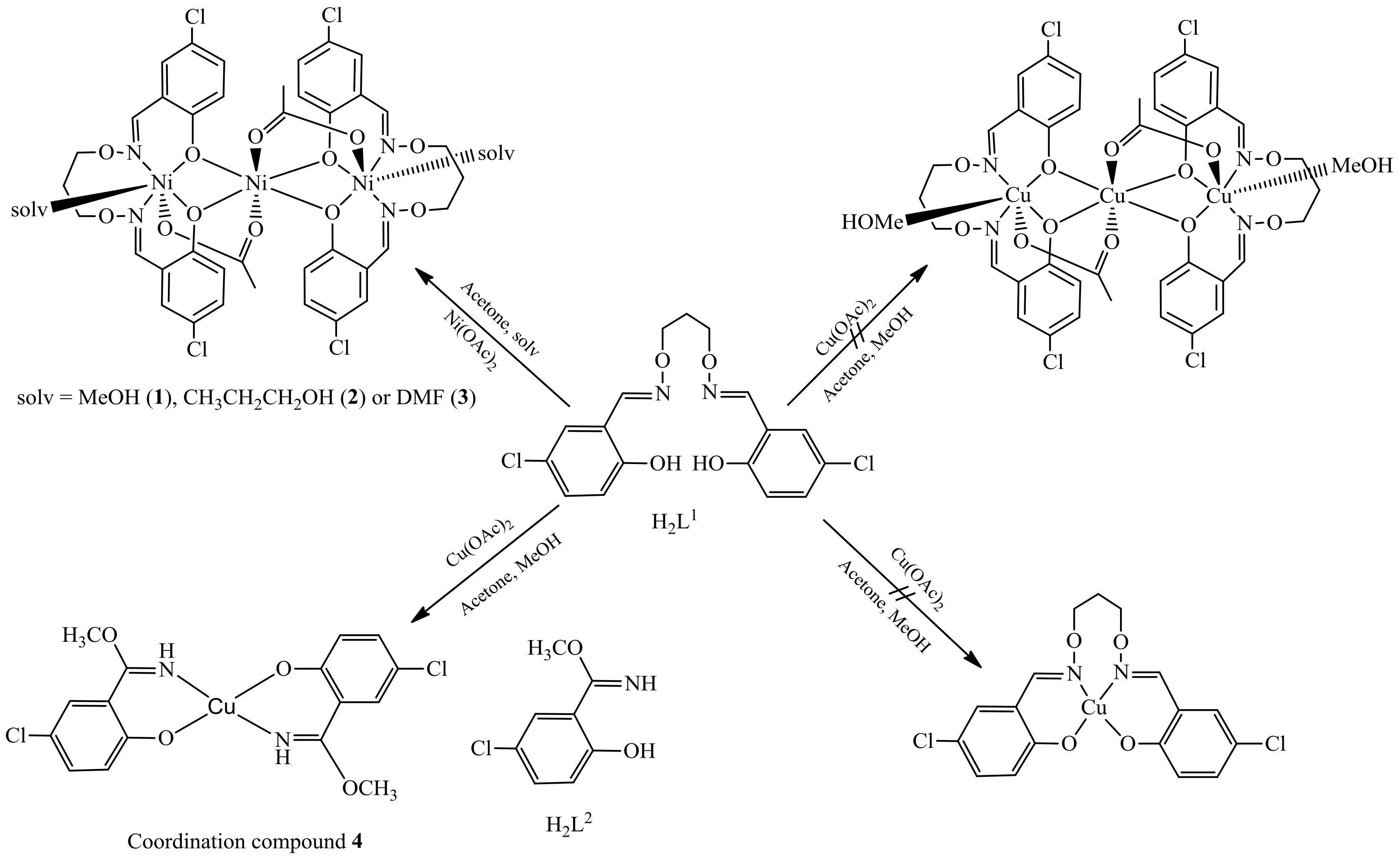
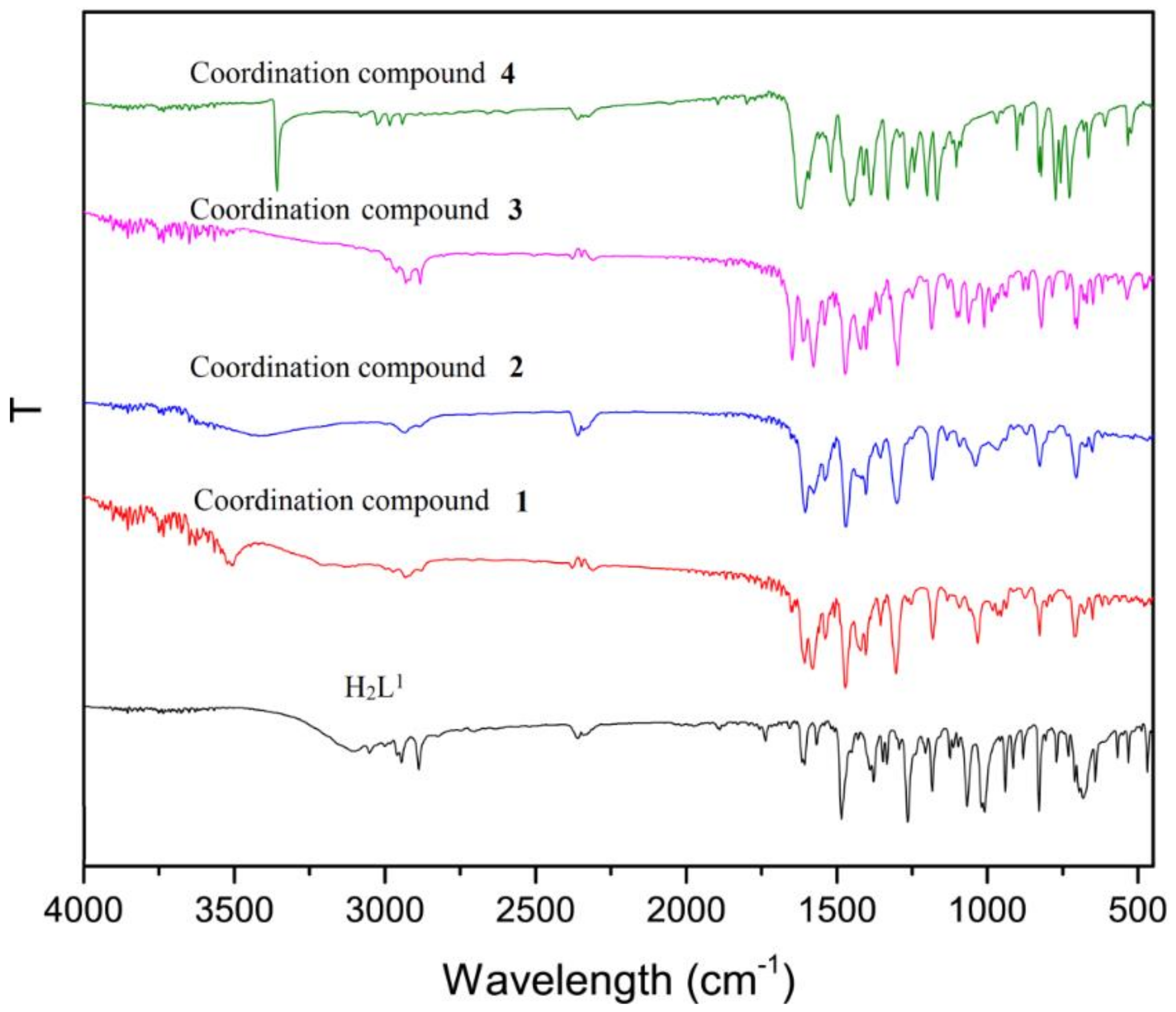
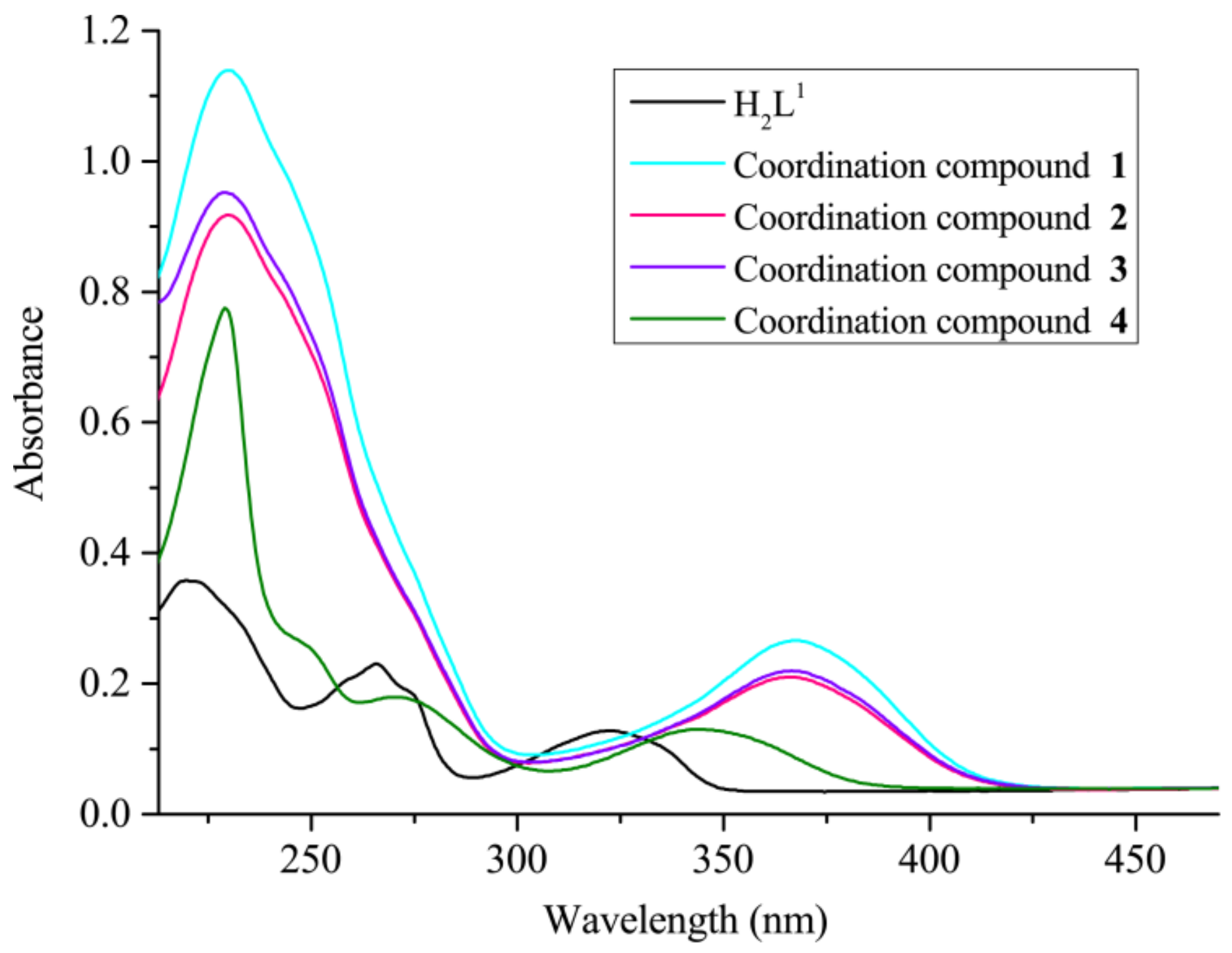


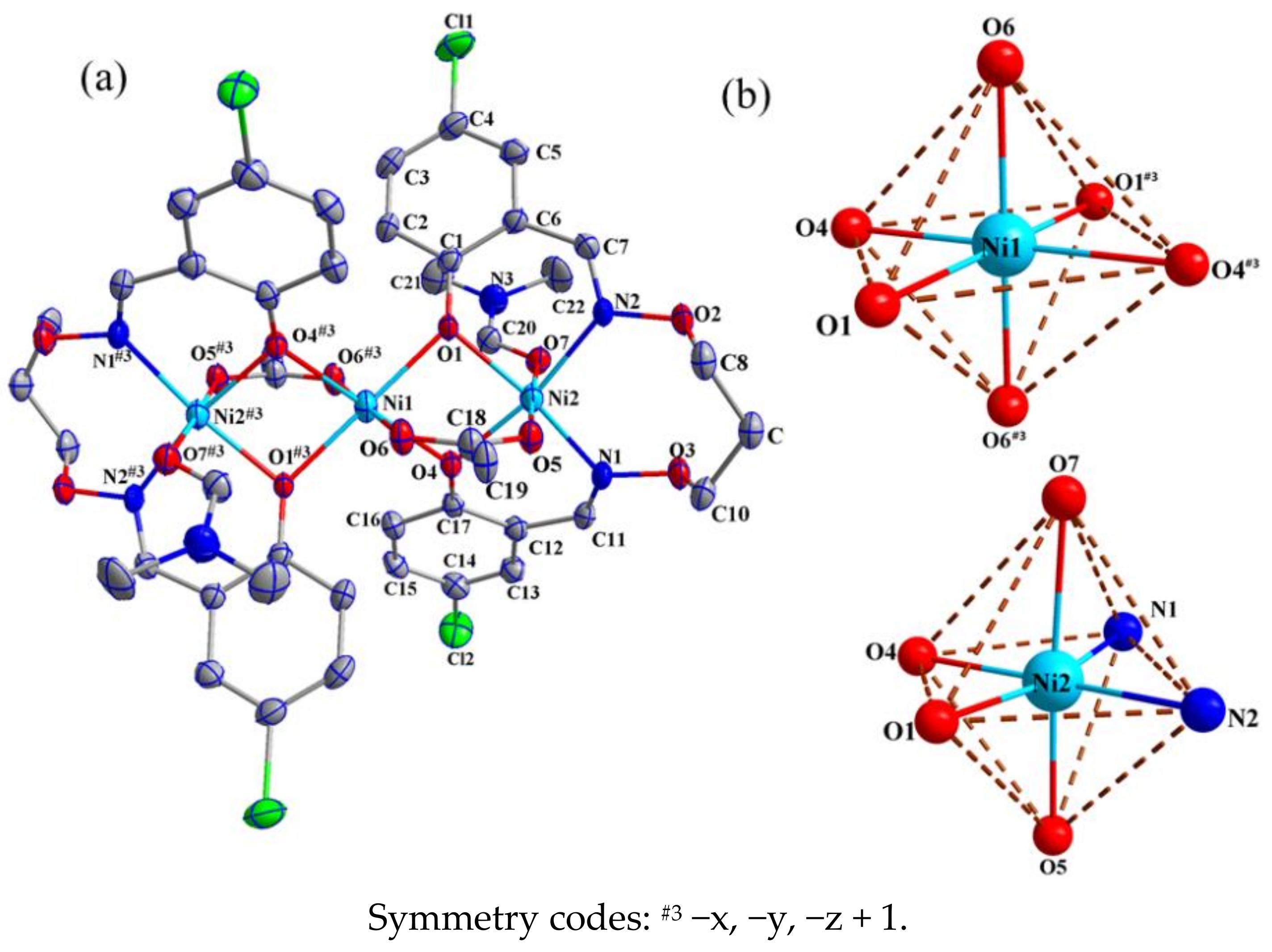
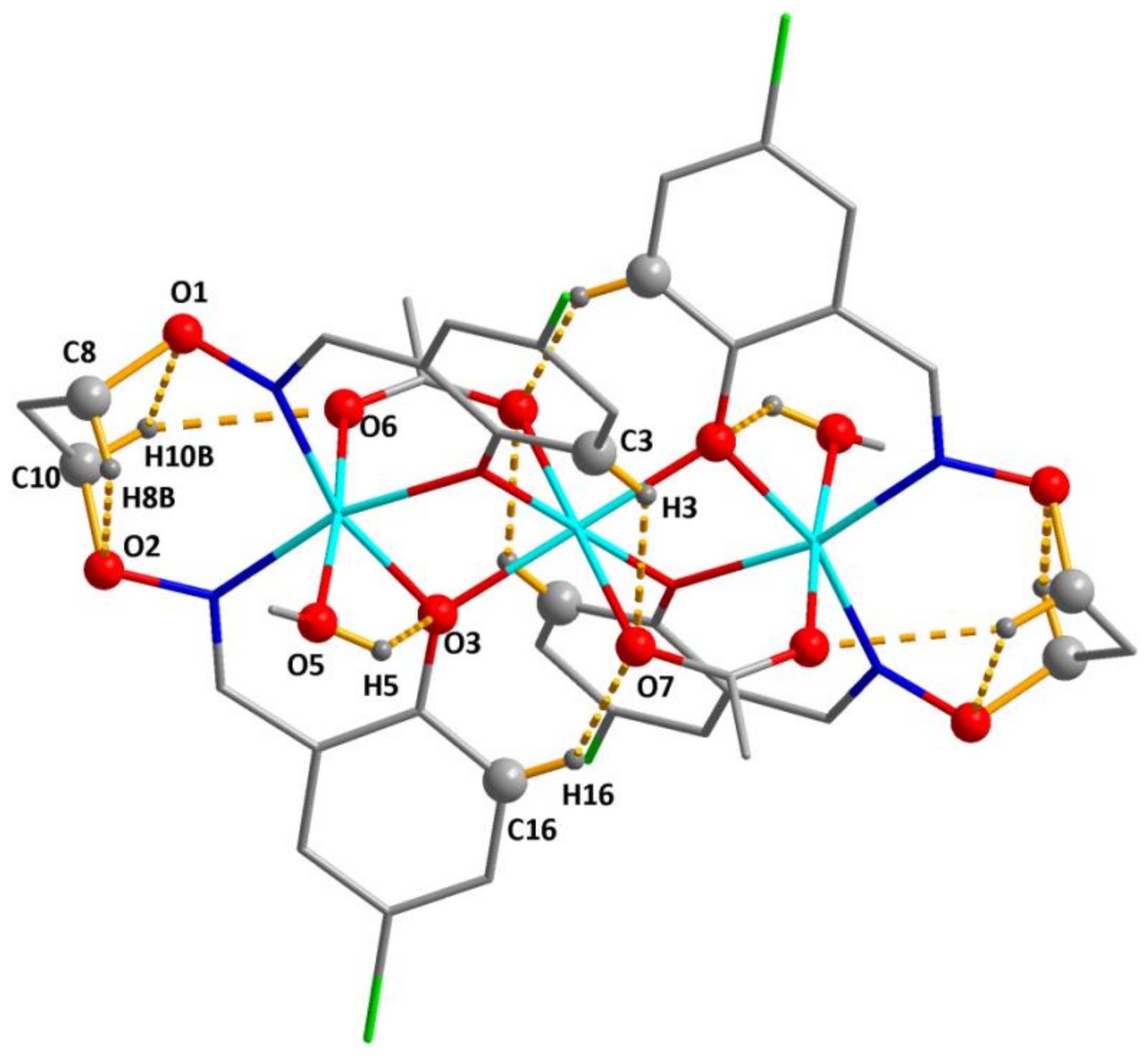
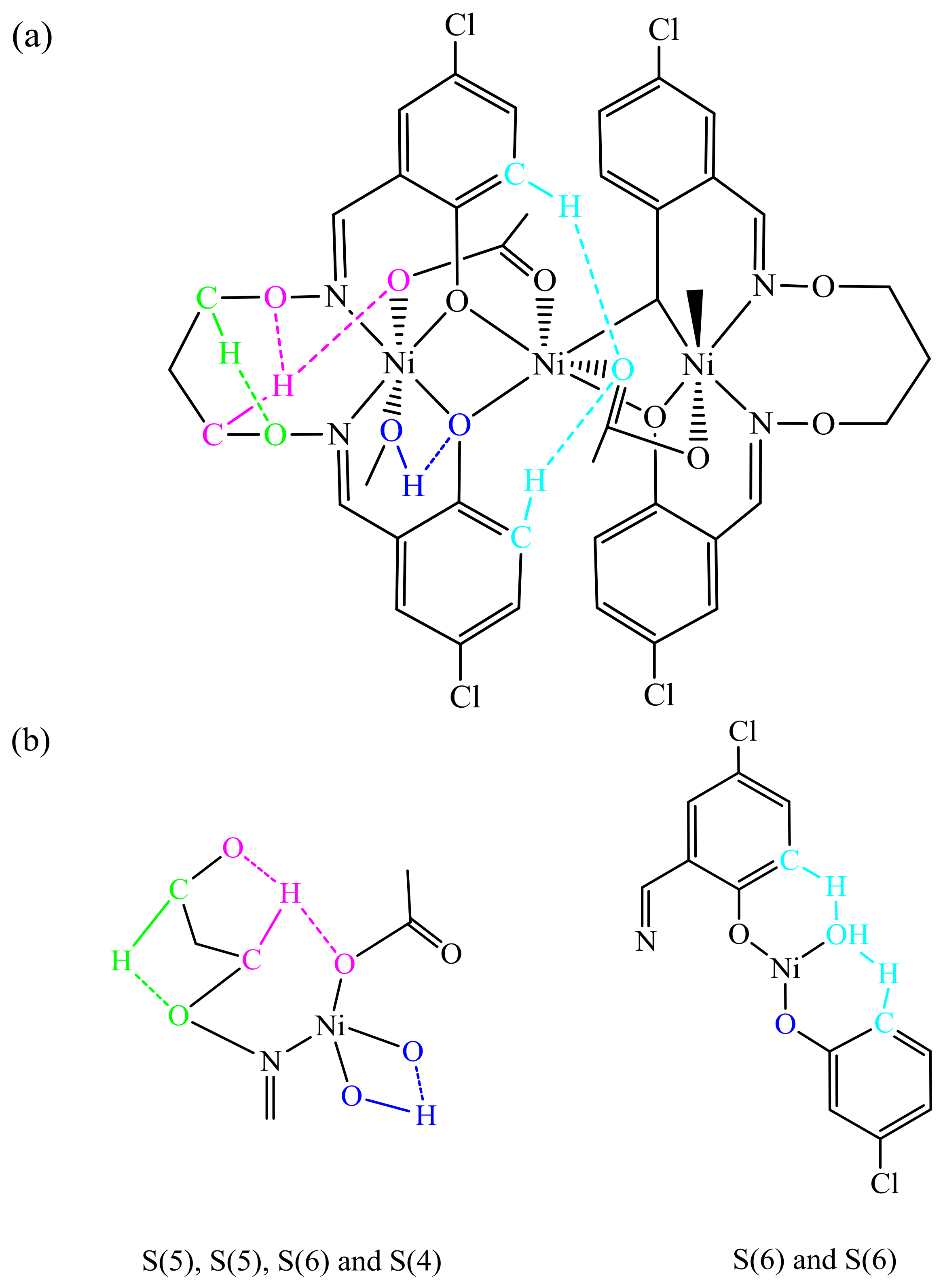
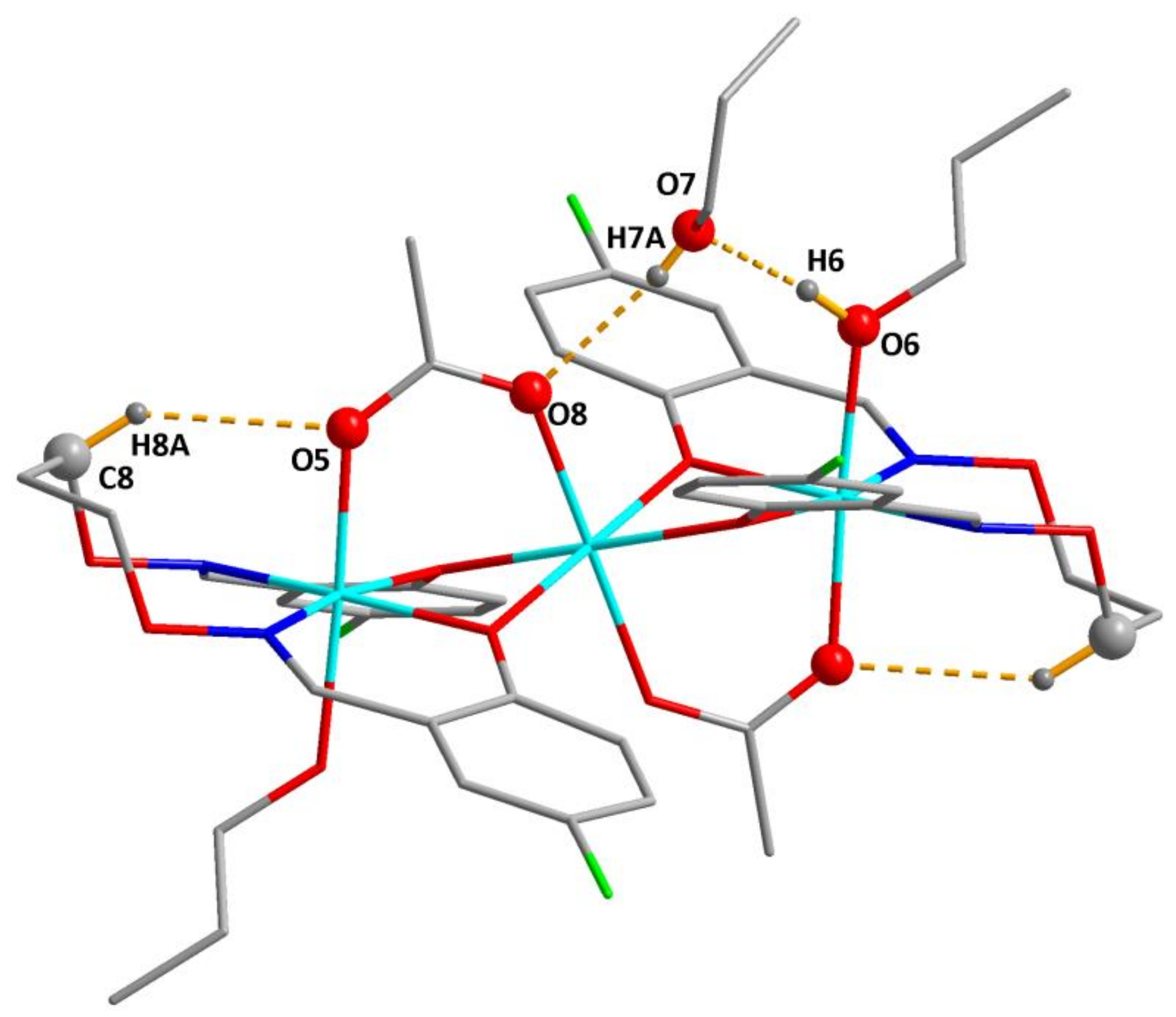

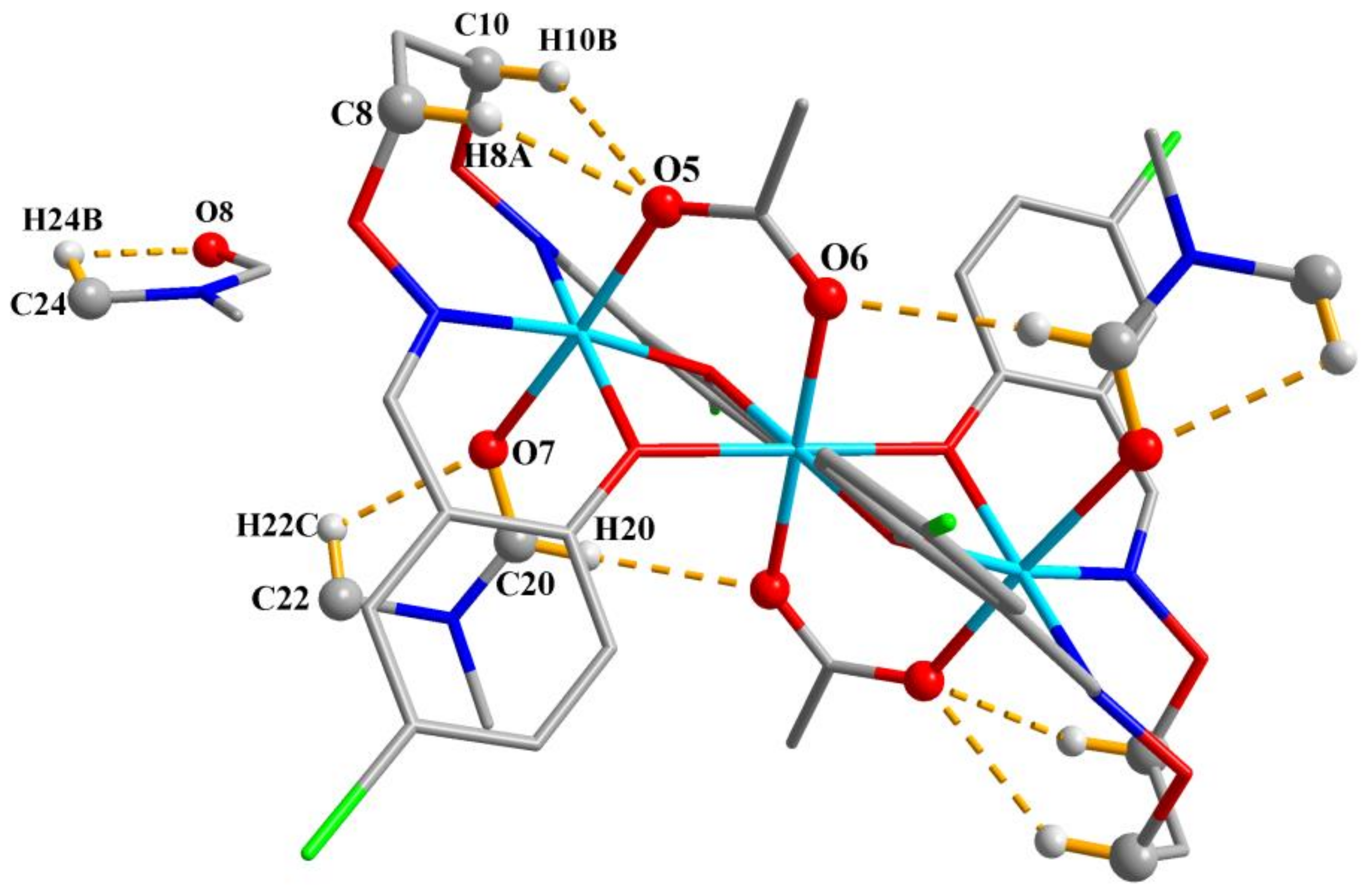


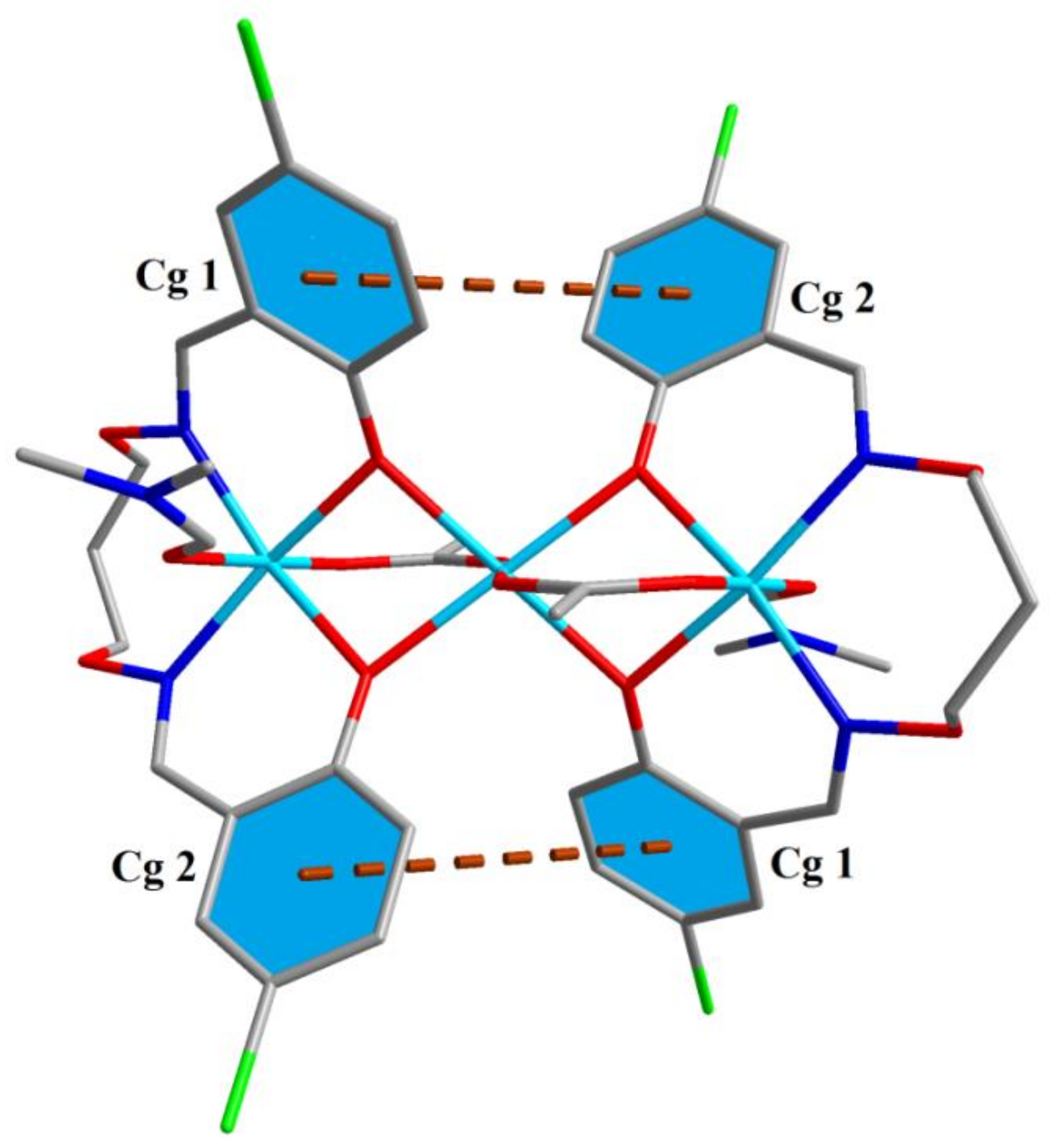
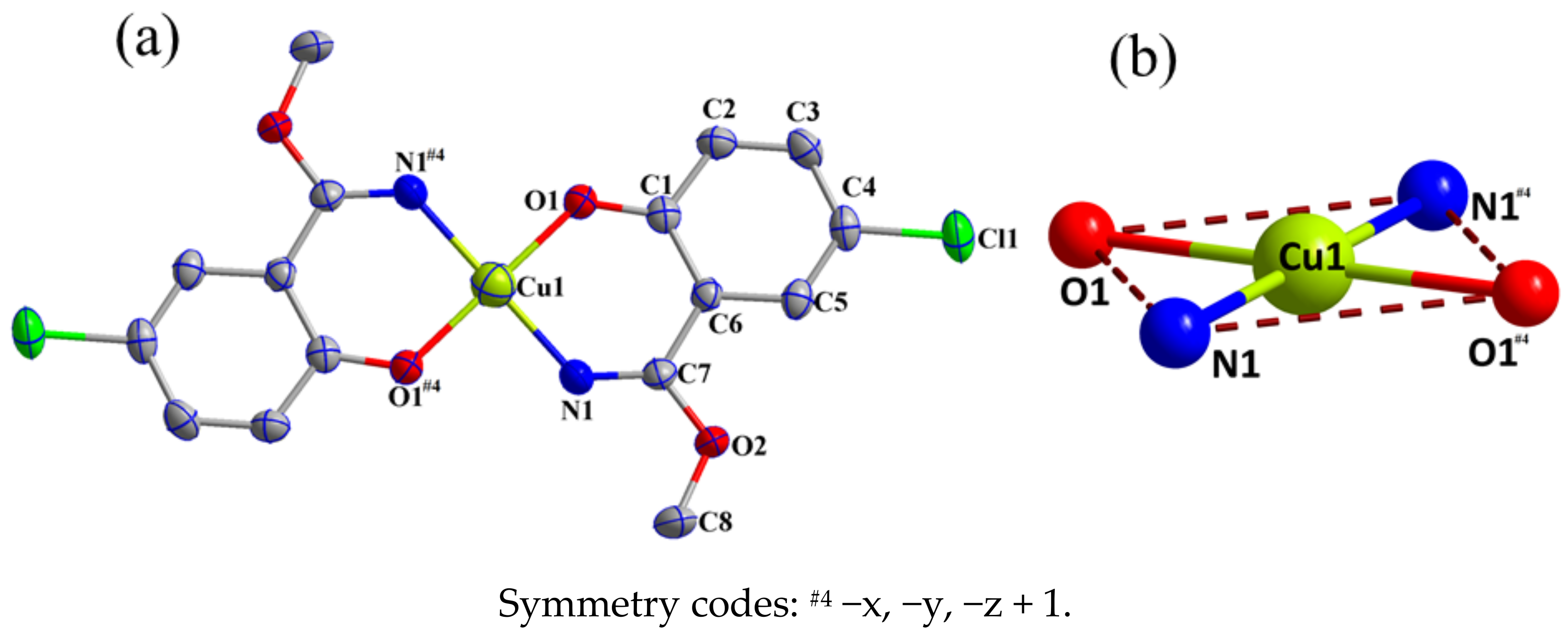


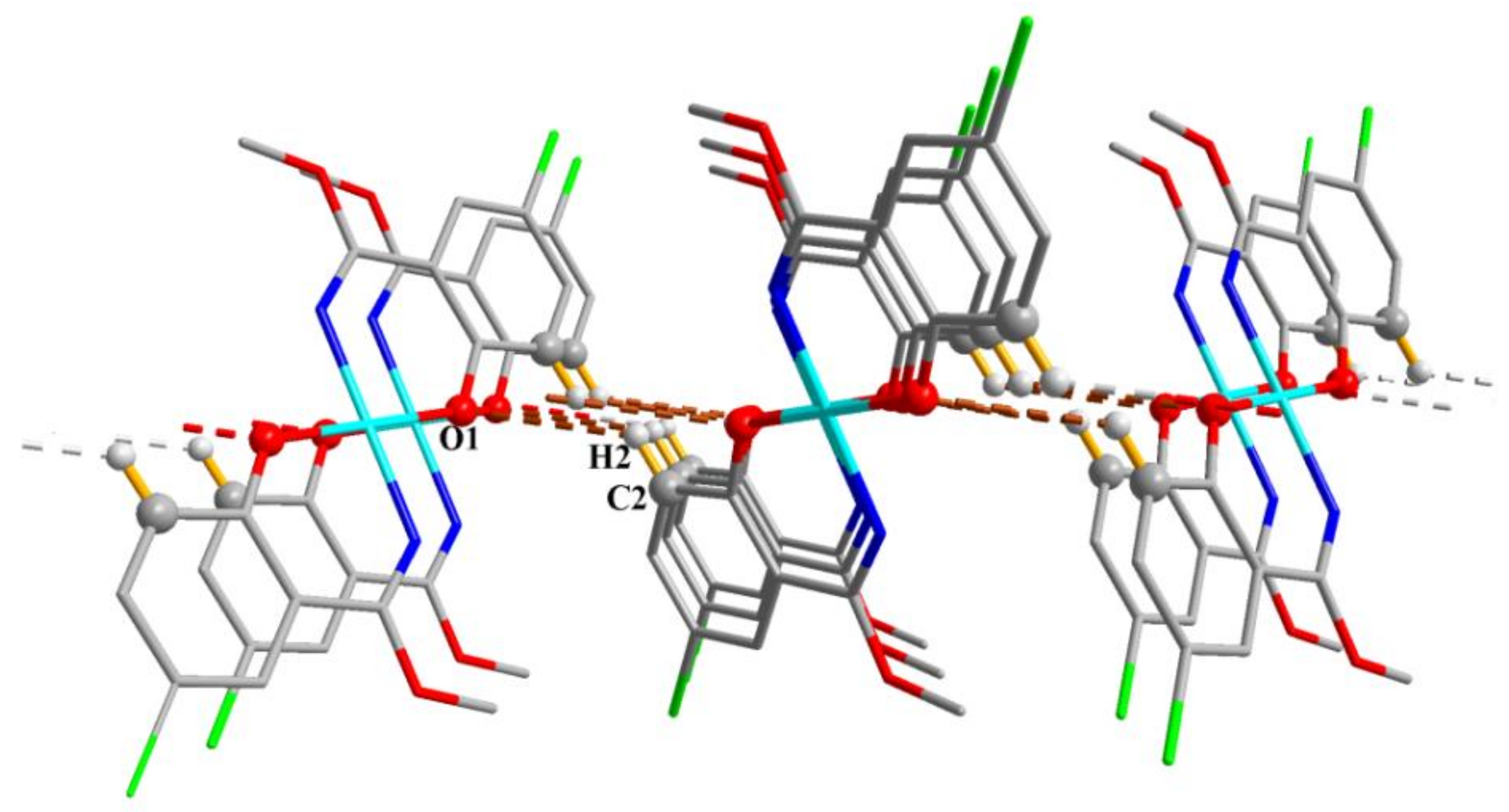
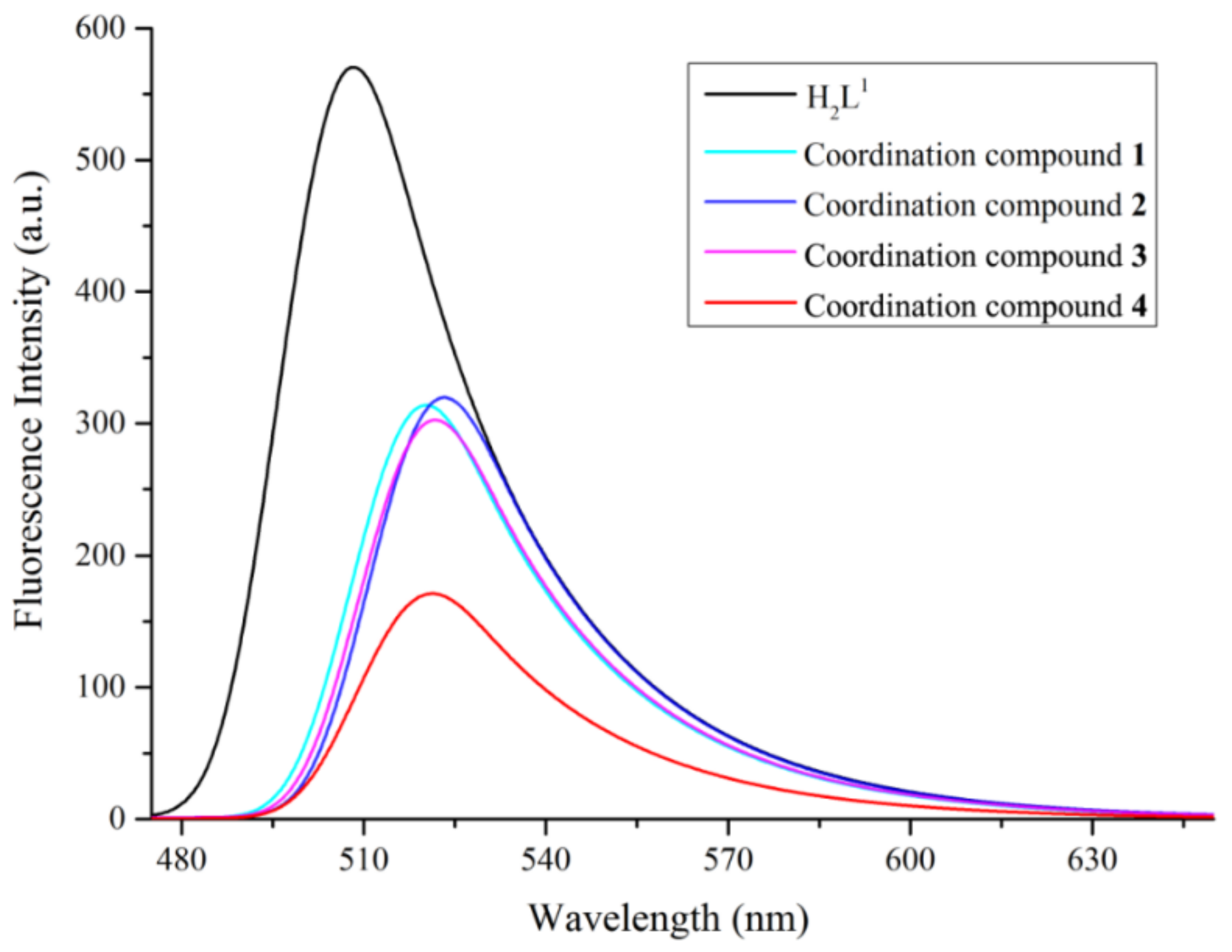
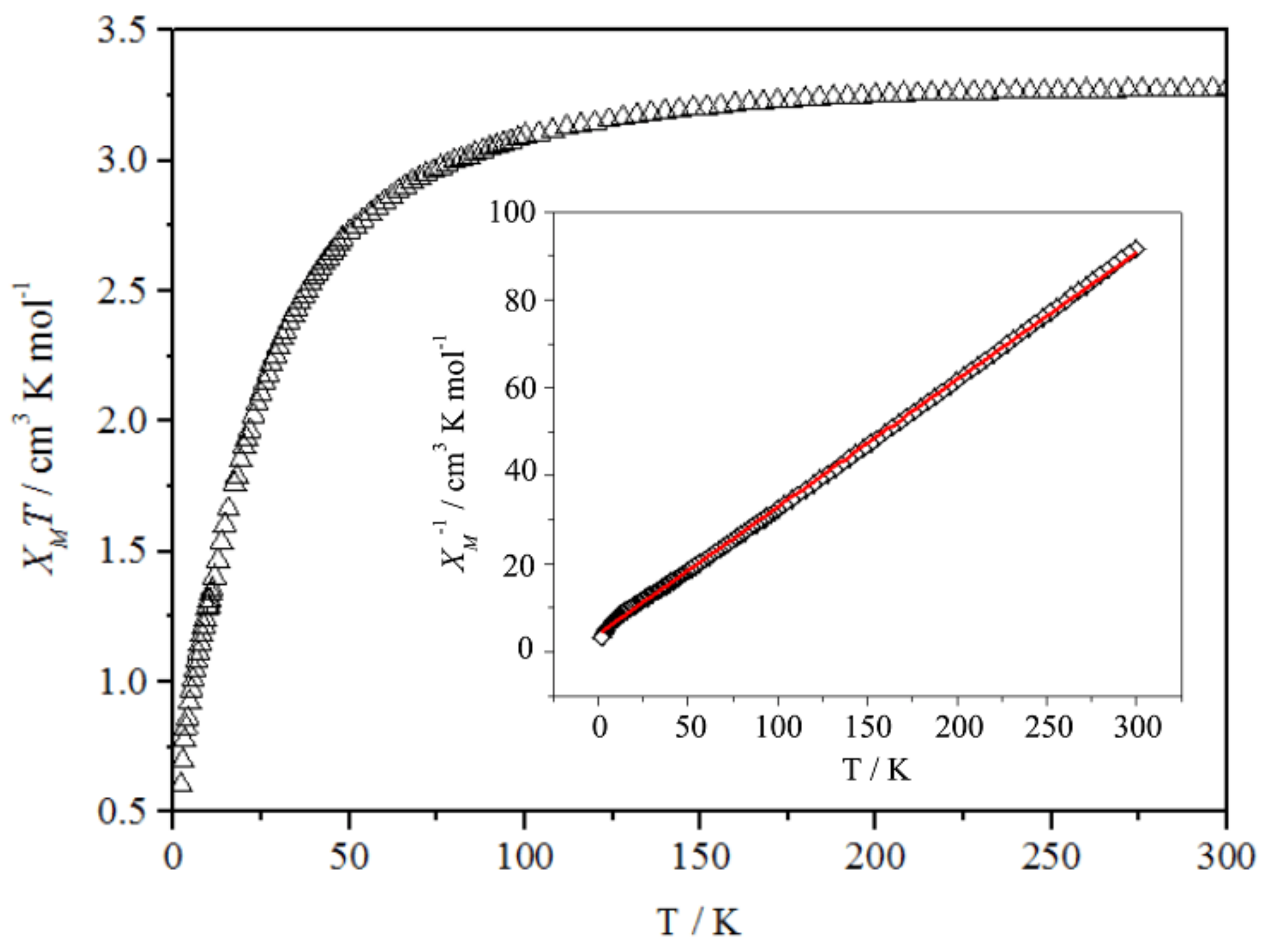
| Coordination Compound | 1 | 2 | 3 | 4 |
|---|---|---|---|---|
| Empirical formula | C40H42Cl4Ni3N4O14 | C50H66Cl4Ni3N4O16 | C49.12H59.94Cl4Ni3N7.71O15.71 | C16H14Cl2CuN2O4 |
| Formula weight | 1120.70 | 1297.00 | 1327.65 | 432.73 |
| T (K) | 293 (2) | 294.39 (10) | 293 (2) | 293 (2) |
| Wavelength (Å) | 0.71073 | 0.71073 | 0.71073 | 0.71073 |
| Crystal system | triclinic | triclinic | triclinic | monoclinic |
| Space group | P − 1 | P − 1 | P − 1 | C 2/c |
| a (Å) | 9.289 (8) | 9.4955 (7) | 11.3008 (8) | 23.652 (3) |
| b (Å) | 11.630 (10) | 12.1979 (7) | 11.3069 (10) | 5.0493 (6) |
| c (Å) | 14.042 (12) | 13.4593 (9) | 12.1027 (10) | 13.7190 (17) |
| α (°) | 67.599 (10) | 70.556 (6) | 102.513 (7) | 90 |
| β (°) | 76.686 (10) | 81.564 (6) | 100.115 (7) | 95.195 (12) |
| γ (°) | 87.161 (12) | 82.607 (6) | 94.689 (7) | 90 |
| V (Å3) | 1364 (2) | 1448.76 (17) | 1474.7 (2) | 1631.7 (3) |
| Z | 1 | 1 | 1 | 4 |
| Dcalc (g∙cm–3) | 1.365 | 1.487 | 1.495 | 1.762 |
| Absorption coefficient (mm–1) | 1.279 | 1.217 | 1.199 | 1.691 |
| F (000) | 574 | 674 | 686 | 876 |
| Crystal size (mm) | 0.19 × 0.22 × 0.26 | 0.24 × 0.25 × 0.29 | 0.17 × 0.24 × 0.26 | 0.04 × 0.05 × 0.37 |
| θ Range (°) | 1.611–26.492 | 3.40–26.02 | 3.519–26.020 | 3.31–26.02 |
| Index ranges | –11 ≤ h ≤ 11 | –11 ≤ h ≤ 11 | –13 ≤ h ≤ 13 | –23 ≤ h ≤ 28 |
| –14 ≤ k ≤ 13 | –15 ≤ k ≤ 14 | –13 ≤ k ≤ 13 | –6 ≤ k ≤ 3 | |
| –17 ≤ l ≤ 17 | –16 ≤ l ≤ 16 | –14 ≤ l ≤ 14 | –12 ≤ l ≤ 16 | |
| Reflections collected/unique | 10,579/5502 [Rint = 0.0713] | 9926/5688 [Rint = 0.0369] | 10,346/5788 [Rint = 0.0374] | 3049/1608 [Rint = 0.0259] |
| Completeness to θ | 97.7% (θ = 25.24) | 99.8% (θ = 26.00) | 99.8% (θ = 25.242) | 99.9% (θ = 25.50) |
| Data/restraints/parameters | 5502/0/297 | 5688/3/359 | 5788/36/373 | 1608/0/120 |
| GOF | 1.041 | 1.038 | 1.053 | 1.061 |
| Final R1, wR2 indices | 0.0747, 0.1880 | 0.0492, 0.1081 | 0.0524, 0.1188 | 0.0376, 0.0833 |
| R1, wR2 indices (all data) | 0.1330, 0.2102 | 0.0721, 0.1239 | 0.0821, 0.1422 | 0.0517, 0.0948 |
| Coordination Compound 1 | Coordination Compound 2 | Coordination Compound 3 | |||
|---|---|---|---|---|---|
| Bond | Lengths | Bond | Lengths | Bond | Lengths |
| Ni1-O3 | 2.012(4) | Ni1-O1 | 2.019(2) | Ni1-O1 | 2.085(3) |
| Ni1-O4 | 2.021(4) | Ni1-O4 | 2.023(2) | Ni1-O4 | 2.106(2) |
| Ni1-O5 | 2.099(5) | Ni1-O5 | 2.035(2) | Ni1-O6 | 2.033(3) |
| Ni1-O6 | 2.029(5) | Ni1-O6 | 2.112(3) | Ni1-O1 #3 | 2.085(3) |
| Ni1-N1 | 2.088(5) | Ni1-N1 | 2.057(3) | Ni1-O4 #3 | 2.106(2) |
| Ni1-N2 | 2.074(5) | Ni1-N2 | 2.057(3) | Ni1-O6 #3 | 2.032(3) |
| Ni2-O3 | 2.067(4) | Ni2-O1 | 2.071(2) | Ni2-O1 | 2.032(2) |
| Ni2-O3 #1 | 2.067(4) | Ni2-O1 #2 | 2.071(2) | Ni2-O4 | 2.032(3) |
| Ni2-O4 | 2.041(4) | Ni2-O4 | 2.080(2) | Ni2-O5 | 2.023(3) |
| Ni2-O4 #1 | 2.041(4) | Ni2-O4 #2 | 2.080(2) | Ni2-O7 | 2.167(3) |
| Ni2-O7 | 2.072(5) | Ni2-O8 | 2.084(2) | Ni2-N1 | 2.053(3) |
| Ni2-O7 #1 | 2.072(5) | Ni2-O8 #2 | 2.084(2) | Ni2-N2 | 2.072(4) |
| Bond | Angles | Bond | Angles | Bond | Angles |
| O3-Ni1-O4 | 78.32(15) | O1-Ni1-O4 | 79.68(10) | O1-Ni1-O4 | 79.36(10) |
| O3-Ni1-O5 | 90.92(17) | O1-Ni1-O5 | 91.06(10) | O1-Ni1-O1 #3 | 180.0 |
| O3-Ni1-O6 | 91.44(17) | O1-Ni1-O6 | 91.24(10) | O1-Ni1-O4 #3 | 100.64(10) |
| O3-Ni1-N1 | 86.93(16) | O1-Ni1-N1 | 87.83(11) | O6-Ni1-O1 | 87.39(11) |
| O3-Ni1-N2 | 163.80(17) | O1-Ni1-N2 | 167.87(11) | O6-Ni1-O4 | 90.14(11) |
| O4-Ni1-O5 | 89.55(19) | O4-Ni1-O5 | 93.90(10) | O6-Ni1-O4 #3 | 89.86(11) |
| O4-Ni1-O6 | 95.26(18) | O4-Ni1-O6 | 88.25(11) | O6-Ni1-O1 #3 | 92.62(11) |
| O4-Ni1-N1 | 164.23(18) | O4-Ni1-N1 | 166.63(11) | O6-Ni1-O6 #3 | 180.0 |
| O4-Ni1-N2 | 85.86(17) | O4-Ni1-N2 | 88.34(11) | O1 #3-Ni1-O4 #3 | 79.36(10) |
| O5-Ni1-O6 | 174.98(16) | O5-Ni1-O6 | 177.10(10) | O1 #3-Ni1-O4 | 100.64(10) |
| O5-Ni1-N1 | 85.1(2) | O5-Ni1-N1 | 91.04(11) | O4 #3-Ni1-O4 | 180.0 |
| O5-Ni1-N2 | 92.4(2) | O5-Ni1-N2 | 91.68(11) | O6 #3-Ni1-O4 #3 | 90.14(11) |
| O6-Ni1-N1 | 90.6(2) | O6-Ni1-N1 | 87.28(13) | O6 #3-Ni1-O1 #3 | 92.62(11) |
| O6-Ni1-N2 | 86.5(2) | O6-Ni1-N2 | 86.43(12) | O6 #3-Ni1-O1 | 92.61(11) |
| N1-Ni1-N2 | 109.15(18) | N1-Ni1-N2 | 103.93(12) | O6 #3-Ni1-O4 | 89.86(11) |
| O3-Ni2-O3 #1 | 180.0 | O1-Ni2-O1 #2 | 180.0 | O1-Ni2-O7 | 90.12(11) |
| O3-Ni2-O4 | 76.62(15) | O1-Ni2-O4 | 77.20(9) | O1-Ni2-N1 | 169.59(12) |
| O3-Ni2-O4 #1 | 103.38(15) | O1-Ni2-O4 #2 | 102.80(9) | O1-Ni2-N2 | 86.70(12) |
| O3-Ni2-O7 | 90.29(17) | O1-Ni2-O8 | 90.11(9) | O4-Ni2-N1 | 88.32(12) |
| O3-Ni2-O7 #1 | 89.71(17) | O1-Ni2-O8 #2 | 89.89(9) | O4-Ni2-N2 | 169.28(12) |
| O3 #1-Ni2-O4 | 103.38(15) | O1 #2-Ni2-O4 | 102.80(9) | O4-Ni2-O1 | 82.93(11) |
| O3 #1-Ni2-O4 #1 | 76.62(15) | O1 #2-Ni2-O4 #2 | 77.20(9) | O4-Ni2-O5 | 90.72(11) |
| O3 #1-Ni2-O7 | 89.71(17) | O1 #2-Ni2-O8 | 89.89(9) | O4-Ni2-O7 | 92.00(11) |
| O3 #1-Ni2-O7 #1 | 90.29(17) | O1 #2-Ni2-O8 #2 | 90.11(9) | O5-Ni2-O1 | 91.71(11) |
| O4-Ni2-O4 #1 | 180.0 | O4-Ni2-O4 #2 | 180.00(13) | O5-Ni2-O7 | 176.89(11) |
| O4-Ni2-O7 | 88.39(16) | O4-Ni2-O8 | 89.72(9) | O5-Ni2-N1 | 94.04(12) |
| O4-Ni2-O7 #1 | 91.61(16) | O4-Ni2-O8 #2 | 90.28(9) | O5-Ni2-N2 | 92.32(13) |
| O4 #1-Ni2-O7 | 91.61(16) | O4 #2-Ni2-O8 | 90.28(9) | N1-Ni2-O7 | 84.54(12) |
| O4 #1-Ni2-O7 #1 | 88.39(16) | O4 #2-Ni2-O8 #2 | 89.72(9) | N1-Ni2-N2 | 101.71(13) |
| O7-Ni2-O7 #1 | 180.0(2) | O8-Ni2-O8 #2 | 180.0 | N2-Ni2-O7 | 85.27(13) |
| Bond | Lengths | Bond | Lengths |
|---|---|---|---|
| Cu1-O1 | 1.910(2) | Cu1-O1 #4 | 1.910(2) |
| Cu1-N1 | 1.915(3) | Cu1-N1 #4 | 1.915(3) |
| Bond | Angles | Bond | Angles |
| O1-Cu1-O1 #4 | 180.0 | O1-Cu1-N1 | 87.92(11) |
| O1-Cu1-N1 #4 | 92.08(11) | O1 #4-Cu1-N1 | 92.08(11) |
| O1 #4-Cu1-N1 #4 | 87.93(11) | N1-Cu1-N1 #4 | 180.0 |
| D–H⋯A | d(D–H) | d(H–A) | d(D–A) | ∠D–X–A |
|---|---|---|---|---|
| Coordination compound 1 | ||||
| O5–H5⋯O3 | 0.87 | 2.57 | 2.932(7) | 106 |
| C3–H3⋯O7 | 0.93 | 2.53 | 3.238(7) | 133 |
| C8–H8B⋯O2 | 0.97 | 2.44 | 2.810(8) | 102 |
| C10–H10B⋯O1 | 0.97 | 2.56 | 2.888(9) | 100 |
| C10–H10B⋯O6 | 0.97 | 2.48 | 3.381(10) | 154 |
| C16–H16⋯O7 | 0.93 | 2.58 | 3.234(8) | 128 |
| Coordination compound 2 | ||||
| O6–H6⋯O7 | 0.86(4) | 1.78(4) | 2.637(5) | 174(2) |
| O7–H7A⋯O8 | 0.70(5) | 2.08(5) | 2.777(4) | 171(5) |
| C8–H8A⋯O5 | 0.97 | 2.55 | 3.380(6) | 143 |
| Coordination compound 3 | ||||
| C8–H8A⋯O5 | 0.97 | 2.38 | 3.226(6) | 146 |
| C10–H10B⋯O5 | 0.97 | 2.55 | 3.340(5) | 138 |
| C20–H20⋯O6 | 0.93 | 2.45 | 3.360(5) | 167 |
| C22–H22C⋯O7 | 0.96 | 2.42 | 2.752(8) | 100 |
| C24–H24B⋯O8 | 0.96 | 2.15 | 2.543(17) | 103 |
| C13–H13⋯O8 | 0.93 | 2.48 | 3.306(10) | 149 |
| C25–H25B⋯O3 | 0.96 | 2.48 | 3.418(13) | 165 |
| C23–H23⋯O8 | 0.93 | 2.60 | 3.328(16) | 139 |
| Coordination compound 4 | ||||
| N1–H1⋯O1 | 0.70(4) | 2.45(3) | 2.655(4) | 100(3) |
| C5–H5⋯O2 | 0.93 | 2.28 | 2.633(4) | 102 |
© 2018 by the authors. Licensee MDPI, Basel, Switzerland. This article is an open access article distributed under the terms and conditions of the Creative Commons Attribution (CC BY) license (http://creativecommons.org/licenses/by/4.0/).
Share and Cite
Zhang, L.-W.; Li, X.-Y.; Kang, Q.-P.; Liu, L.-Z.; Ma, J.-C.; Dong, W.-K. Structures and Fluorescent and Magnetic Behaviors of Newly Synthesized NiII and CuII Coordination Compounds. Crystals 2018, 8, 173. https://doi.org/10.3390/cryst8040173
Zhang L-W, Li X-Y, Kang Q-P, Liu L-Z, Ma J-C, Dong W-K. Structures and Fluorescent and Magnetic Behaviors of Newly Synthesized NiII and CuII Coordination Compounds. Crystals. 2018; 8(4):173. https://doi.org/10.3390/cryst8040173
Chicago/Turabian StyleZhang, Lin-Wei, Xiao-Yan Li, Quan-Peng Kang, Ling-Zhi Liu, Jian-Chun Ma, and Wen-Kui Dong. 2018. "Structures and Fluorescent and Magnetic Behaviors of Newly Synthesized NiII and CuII Coordination Compounds" Crystals 8, no. 4: 173. https://doi.org/10.3390/cryst8040173
APA StyleZhang, L.-W., Li, X.-Y., Kang, Q.-P., Liu, L.-Z., Ma, J.-C., & Dong, W.-K. (2018). Structures and Fluorescent and Magnetic Behaviors of Newly Synthesized NiII and CuII Coordination Compounds. Crystals, 8(4), 173. https://doi.org/10.3390/cryst8040173






